Paraguay |
|
|
|
| Übersicht – Contents: | |
Paraguay |
|
|
|
| Übersicht – Contents: | |
Flaggen – Flags: |
|
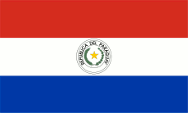 |
seit/since 2013, Nationalflagge – national flag, Vorderseite – obverse, Seitenverhältnis – ratio = 3:5 (11:20?), Quelle/Source, nach/by: Flags of the World |
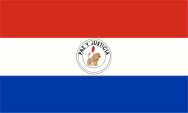 |
seit/since 2013, Nationalflagge – national flag, Rückseite – reverse, Seitenverhältnis – ratio = 3:5 (11:20?), Quelle/Source, nach/by: Flags of the World |
 |
Gösch – naval jack, Seitenverhältnis – ratio = 1:1, Quelle/Source, nach/by: Flags of the World |
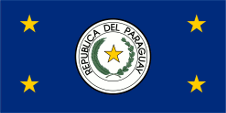 |
Flagge des Präsidenten – flag of the President, Seitenverhältnis – ratio = 1:2, Quelle/Source, nach/by: Wikipedia (EN) |
historische Flaggen – historical Flags: |
|
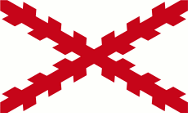 |
1527–1777, zum spanischen Vizekönigreich Peru – to the Spanish Vice–Kingdom of Peru, Quelle/Source, nach/by: Wikipedia (ES)  |
 |
1777–1785, zum span. Vizekönigreich Río de la Plata – to the Span. Vice–Kingdom of Río de la Plata, Quelle/Source, nach/by: Wikipedia (ES)  |
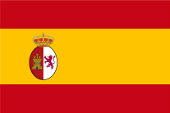 |
1785–1811, zum span. Vizekönigreich Río de la Plata – to the Span. Vice–Kingdom of Río de la Plata, Quelle/Source, nach/by: Wikipedia (ES)  |
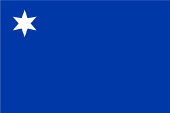 |
1811, Nationalflagge – national flag, Quelle/Source, nach/by: Flags of the World |
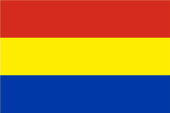 |
1811, Nationalflagge – national flag, Quelle/Source, nach/by: Flags of the World |
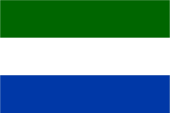 |
1811, Nationalflagge – national flag, Quelle/Source, nach/by: Flags of the World |
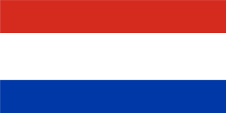 |
1812–1826, Nationalflagge – national flag, Quelle/Source, nach/by: Flags of the World |
 |
1826–1842, Nationalflagge – national flag, Quelle/Source, nach/by: Flags of the World |
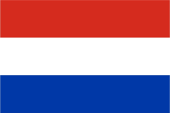 |
1826–1842, Nationalflagge – national flag, alternative Version – alternative version, Quelle/Source, nach/by: Flags of the World |
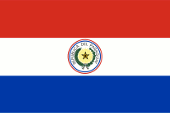 |
1842–1954, Nationalflagge – national flag, Vorderseite – obverse, Seitenverhältnis – ratio = 2:3, Quelle/Source, nach/by: Flags of the World |
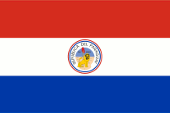 |
1842–1954, Nationalflagge – national flag, Rückseite – reverse, Seitenverhältnis – ratio = 2:3, Quelle/Source, nach/by: Flags of the World |
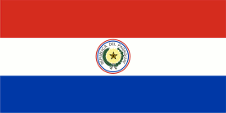 |
1854–1988, Nationalflagge – national flag, Vorderseite – obverse, Seitenverhältnis – ratio = 1:2, Quelle/Source, nach/by: Flags of the World |
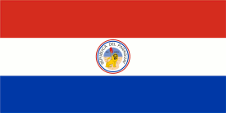 |
1854–1988, Nationalflagge – national flag, Rückseite – reverse, Seitenverhältnis – ratio = 1:2, Quelle/Source, nach/by: Flags of the World |
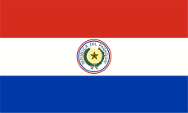 |
1988–1990, Nationalflagge – national flag, Vorderseite – obverse, Seitenverhältnis – ratio = 3:5, Quelle/Source, nach/by: Flags of the World |
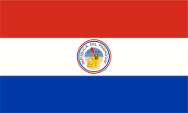 |
1988–1990, Nationalflagge – national flag, Rückseite – reverse, Seitenverhältnis – ratio = 3:5, Quelle/Source, nach/by: Flags of the World |
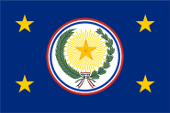 |
bis/to 1990, Flagge des Präsidenten – flag of the President, Seitenverhältnis – ratio = 2:3(?), Quelle/Source, nach/by: Flags of the World, Flaggenbuch 1939 |
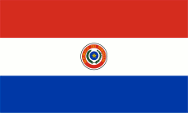 |
1990–2013, Nationalflagge – national flag, Vorderseite – obverse, Seitenverhältnis – ratio = 3:5, Quelle/Source, nach/by: Flags of the World   |
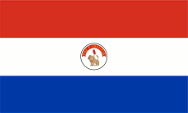 |
1990–2013, Nationalflagge – national flag, Rückseite – reverse, Seitenverhältnis – ratio = 3:5, Quelle/Source, nach/by: Flags of the World |
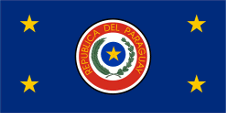 |
1990–2013, Flagge des Präsidenten – flag of the President, Seitenverhältnis – ratio = 1:2, Quelle/Source, nach/by: Flags of the World |
| Die heutige Flagge Paraguays wurde am 27.11.1842 offiziell eingeführt, und in den Jahren 1954, 1988, 1990 und 2013 lediglich im Format oder in dem in der Mitte der Flagge angebrachten Siegel abgeändert. Sie ist eine der wenigen Flaggen der Welt, bei der sich Vorder- und Rückseite unterscheiden. | The today’s flag of Paraguay was officially introduced on 27th of November in 1842 and in the years 1954, 1988, 1990 and 2013 merely changed in the side ratio or in the into the middle of the flag placed seal. It is one of the few flags in the world where the front and the reverse of the flag are different. |
| Die Flagge zeigt drei waagerechte Streifen in Rot, Weiß und Blau. In der Mitte des weißen Streifens befindet sich auf der einen Seite der Flagge das Staatswappen (Siegel) und auf der anderen Seite das Siegel des Finanzministeriums. Die Farben der Flagge sind per Gesetz von 1842 festgelegt, allerdings nur als als Rot, Weiß und Blau, ohne genauer zu spezifizieren. Die heutigen Farben scheinen aus der Praxis heraus definiert zu sein: Rot = HEX #D52B1E, was Pantone 1795 entsprechen würde, Blau = HEX #0038A8, was Pantone 661 entsprechen würde. | The flag
shows three horizontal stripes in red, white and blue. In the middle of the
white stripe is placed on the one side of the flag the coat of arms (seal)
of the state and one the other side the seal of the ministry of finance. The colours of the flag are defined by law from 1842, but only as red, white and blue, without specifying more precisely. Today's colours seem to be defined from practice: Red = HEX #D52B1E, which would correspond to Pantone 1795, Blue = HEX #0038A8, which would correspond to Pantone 661. |
| Am 25.05.1810, war in La Plata (zu dem Paraguay damals gehörte) der spanische Vizekönig gestürzt worden. Es war ein trüber und wolkiger Tag, an dem plötzlich die Wolkendecke aufriss und die Sonne zu scheinen begann. Dieses Wunder wurde im späteren Argentinien als "Sol de Mayo" (Maisonne) berühmt und auf der Flagge dieses Landes verewigt. | On 25th of May in 1810 was overthrowed in La Plata (where Paraguay at that time belonged) the Spanish Vice-King. It was a bleak and cloudy day on which the roof of clouds suddenly splited and the sun began to shine. That miracle became then renowned in the later Argentina as "Sol de Mayo" (May-Sun) and immortalized on the flag of that country. |
| Die Verkündung Unabhängigkeit Paraguays sollte ursprünglich auf den 14.05.1811 fallen. Ein Datum in Mai! Fast ein Jahr nach den Ereignissen in Argentinien! Um auch in Paraguay ein "Wunder" wirken zu lassen, wurde für die Nacht vor dem 14.05.1811 ein hell leuchtender Stern prophezeit. Jedenfalls wurde am 14.05.1811 für das unabhängige Paraguay eine einfarbige blaue Flagge mit einem weißen sechszackigen Stern in der Oberecke gehisst. Dieser Stern wurde nun als "Estrella de Mayo" (Maistern) bekannt. | The proclamation of the independence of Paraguay ought initially be executed on the 14th of May in 1811. A datum in May! Nearly one year after the incidents in Argentina! To let appear a "miracle" in Paraguay too, was predicted a brightly shining star for the night before the 14th of May in 1811. Anyway was hoistet on 14th of May in 1811 a single-coloured blue flag with a white six-pointed star in the upper staff quadrant for the independent Paraguay. This star became now known as "Estrella de Mayo" (May-Star). |
| Die tatsächliche Unabhängigkeit von Spanien (und auch von La Plata) wurde jedoch erst am 17.06.1811 verkündet, als sich der Kongress erstmals konstituierte. Dabei wurden eine Vielzahl von Flaggen gezeigt, gehisst und verwendet. Es waren meist Flaggen mit drei horizontalen Streifen in den Farben Grün, Weiß und Blau oder Rot, Gelb und Blau (Farben Spaniens ergänzt um Blau). Der Patriot, Freiheitskämpfer und spätere Staatschef Dr. José Rodríguez Gaspar da Francia bevorzugte eine Flagge in den Farben Rot, Weiß und Blau. Er hatte die Farben Frankreichs ganz bewusst als revolutionäres Vorbild ausgewählt und eine horizontal gestreifte Flagge in diesen Farben wurde am 15.08.1812 als Flagge von Paraguay angenommen. Der weiße Streifen war verbreitert, wahrscheinlich um genügend Raum für ein später zu platzierendes Wappen zu haben. | But the
really independence from Spain (and from La Plata too) was proclaimed not
until the 17th of June in 1811 as the congress constituted for the first
time. There were showed a lot of flags, hoisted and used. It were mostly
flags with three horizontal stripes in the colours green, white and blue or
red, yellow and blue (colours of Spain added by blue). The patriot, freedom fighter and later head of state Dr. José Rodríguez Gaspar da Francia preferred a flag in the colours red, white and blue. He had deliberately chosen the colours of France as a revolutionary model and an horizontally striped flag in these colours was adopted as the flag of Paraguay on 15th of August in 1812. The white stripe was widened, probably to have enough space for a coat of arms to be placed later. |
| Im Jahre 1826 reaktivierte Dr. Francia die einfarbig blaue Flagge mit dem Stern in der Oberecke, angeblich in Hellblau, allerdings wird das zum Färben von Blau verwendete Indigo das getan haben, was es immer macht, es wird ausgewaschen sein. Was das Motiv zum Wiedereinführen der Flagge von 1811 war, ist unbekannt. Die rot-weiß-blaue Flagge wurde aber ebenfalls weiterverwendet und mit dem Flaggengesetz von 1842 mit gleich breiten Streifen, schließlich wieder als alleinige Flagge von Paraguay bestätigt. Das Gesetz, das im Prinzip heute noch gilt, schrieb dann vor, das Siegel des Staates in der Mitte des weißen Streifens zu platzieren, jedoch auf der Rückseite der Flagge das Siegel der Finanzverwaltung zu verwenden. Das das Siegel im Gesetz nur beschrieben und nicht abgebildet war, gab es, bis sich allmählich ein Standard herausarbeitete, viele unterschiedliche Versionen. |
In 1826, Dr. Francia
reactivated the solid blue flag with the star in the top corner, supposedly
in light blue, however the indigo used to dye the colour blue will have done
what it always does, it will have washed out. What the motive was for
reintroducing the 1811 flag is unknown. However, the red, white and blue flag also continued to be used, and with the Flag Law of 1842, with stripes of equal width, it was finally reaffirmed as the sole flag of Paraguay. The law, which in principle still applies until today, then stipulated that the seal of the state is to be be placed in the middle of the white stripe, but the seal of the fiscal administration is to be used on the back side of the flag. Since the seal was only described in the law and not depicted, there were many different versions until a standard gradually emerged. |
| Quelle/Source: Flaggen Wappen Hymnen, Flaggen und Wappen der Welt, Die Welt der Flaggen, Volker Preuß | |
Wappen – Coat of Arms: |
|||||||||||
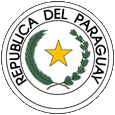 |
seit/since 2013, Wappen (Siegel) von Paraguay – coat of arms (seal) of Paraguay, Quelle/Source, nach/by: Wikipedia (DE) | ||||||||||
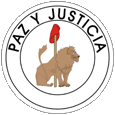 |
seit/since 2013, Siegel des Finanzministeriums – Seal of the Ministry of Finance, Quelle/Source, nach/by: Wikipedia (DE)
|
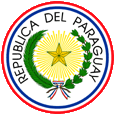
1842–1990, | Wappen (Siegel) von Paraguay – coat of arms (seal) of Paraguay, Quelle/Source, nach/by: Corel Draw 4, Wikipedia (DE)
|
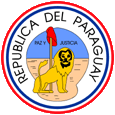
1842–1990, | Siegel des Finanzministeriums – Seal of the Ministry of Finance, Quelle/Source, nach/by: Corel Draw 4, Wikipedia (DE)
|
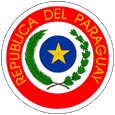
1990–2013, | Wappen (Siegel) von Paraguay – coat of arms (seal) of Paraguay, Quelle/Source, nach/by: Wikipedia (DE)
|
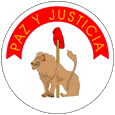
1990–2013, | Siegel des Finanzministeriums – Seal of the Ministry of Finance, Quelle/Source, nach/by: Wikipedia (DE)
|
| |
| Das Staatswappen von Paraguay ist eigentlich ein Siegel. Es geht auf das von Dr. José Rodríguez Gaspar da Francia verwendete Siegel zurück. Dieses zeigte zwei gekreuzte Palmwedel. Im Jahre 1821 wurde der "Maistern" in das Siegel aufgenommen und ein Palmwedel durch einen Ölzweig ersetzt. Die beiden Zweige stehen für Frieden und Ehre. Ebenso erscheint auch der Name des Landes ("REPUBLICA DEL PARAGUAY") im Siegel. Im Jahr 1990 wurde das Siegel ein wenig verändert. Der "Maistern" wurde auf eine blaue Scheibe gelegt und die Strahlen des Sterns wurden entfernt. Ebenso das rot-weiß-blaue Band, welches die Zweige bis dato zusammengehalten hatte. Der Name des Landes wurde in Gold auf ein rotes umlaufendes Band gesetzt. Die äußereste Umrandung ist nicht mehr in den Farben Rot, Weiß und Blau gehalten, sondern ist eine einfache schwarze Linie. | The coat
of arms of Paraguay is actually a seal. It has its roots in the by Dr. José
Rodríguez Gaspar da Francia used seal. That showed two crossed palm fronds.
In 1821 was added the "May-Star" into the seal and one palm frond was substituted by an oil twig. The both twigs stand for peace and honor. The name of the country ("REPUBLICA DEL PARAGUAY") also appears in the seal. In the year 1990 the seal was changed a little bit. The "May-Star" was placed on a blue disk and the rays of the star were removed, just as the red-white-blue ribbon which held the twings until that point in time. The name of the country was placed golden on a red around placed banner. The outermost border is not more designed in the colours red, white and blue, but is formed by a simple black line. |
| Das Siegel des Finanzministeriums, das auf der Rückseite der Landesflagge angebracht ist, zeigt einen Löwen der eine phrygische Mütze bewacht. Diese Symbole stehen für Frieden und Gerechtigkeit und für deren Verteidigung. Auch dieses Siegel wurde im Jahre 1990 abgeändert. Der farbige Hintergrund und die Landesbezeichnung wurden entfernt, und der Löwe schaut nun in die andere Richtung. Das Motto "Paz y Justicia" (Frieden und Gerechtigkeit) wurde auf ein in der oberen Hälfte verlaufendes rotes Band gelegt. | The seal
of the ministry of finance – which is placed on the reverse of the flag –
shows a lion which guards a Phrygian cap. These symbols stand for peace and
justice and for its defense. The seal was also changed in 1990. The colored background and the name of the country were removed and the lion looks now in the other direction. The motto "Paz y Justicia" (Peace and Justice) was placed within an in the upper half positioned red ribbon. |
| Das Siegel des Staates und des Ministeriums für Finanzen wurden im Juli 2013 erneut abgeändert. | The Seal
of the State and the ministry of finance were changed again in July 2013. |
| Quelle/Source: Flaggen Wappen Hymnen, Flaggen und Wappen der Welt, Die Welt der Flaggen, Wikipedia (ES), Volker Preuß | |
Flugzeugkokarde – aircraft roundel: |
|
 |
Flugzeugkokarde – aircraft roundel Quelle/Source, nach/by: Wikipedia (EN) |
Landkarte – Map: |
Lage – Position: |
Landkarte des Landes – Map of the Country: |
| Zahlen und Fakten – Numbers and Facts: | |
|
|
|
|
|
|
|
|
|
|
|
|
|
|
|
|
|
|
| Steinzeit
· indianische Besiedlung des heutigen Paraguay, im Osten
Tupí-Guaraní-Stämme, im Westen (Chaco) Aruak, Guaicurú, Mataco-Mataguayo,
Chamacoco, Angaite und Lengua 1524 · Entdeckung des heutigen Paraguay durch Alejo García bei einer Durchquerung des Chaco, eines unwirtlichen Flachlandes 1526 · Expedition des Sebastiano Caboto, eines italienischen Seefahrers in englischem Dienst, entlang des Flusses Paraná, Gründung einer Siedlung 1537 · Gründung des Forts Asunción durch spanische Eroberer, Bildung der spanischen Kolonie Río de la Plata, Zug des Eroberers Juan de Ayola nach Osten 1542 · Zug des Eroberers Irala von Buenos Aires über Asunción nach Osten 1543 · Zug des Eroberers Cabeza de Vacas nach Osten 1588 · der Jesuitenorden gründet im Süden des heutigen Paraguay einen christlich-theokratischen Indianerstaat 1617 · das heutige Paraguay wird von der Kolonie Río de la Plata abgetrennt und als Provinz dem spanischen Vizekönigreich Peru angeschlossen 1725/1733 · Proteste spanischer Grundbesitzer gegen den Jesuitenorden 1750 · Vertrag von Madrid, Abtretung des Indianerstaats der Jesuiten an Brasilien 1753–1756 · Guaraní-Kriege, von des Jesuiten unterstützte Erhebung der Guaraní-Indianer gegen Brasilien und Spanien 1767 · Vertreibung der Jesuiten aus Paraguay durch Spanien 1776 · Gründung des spanischen Vizekönigreichs Río de la Plata (heutiges Bolivien, Paraguay, Uruguay, Nordargentinien, Nordchile, und der brasilianische Bundesstaat Rio Grande do Sul) durch Abtrennung vom Vizekönigreich Peru 17.06.1811 · Erklärung der Unabhängigkeit von Spanien 12.10.1813 · Proklamation der Republik, damit endgültige Unabhängigkeit von La Plata (Argentinien) 1842 · die Unabhängigkeit von Paraguay wird von Spanien und Argentinien anerkannt 1864–1870 · Krieg Argentiniens, Brasiliens und Uruguays (mit Unterstützung von Frankreich und Großbritannien) gegen Paraguay, Niederlage von Paraguay, Verlust von 4/5 der Bevölkerung und riesigen Teilen seines Territoriums 1932–1935 · Chaco-Krieg Paraguays gegen Bolivien, 130 000 Todesopfer, Bolivien tritt den Chaco zu 2/3 an Paraguay ab 1940 · Errichtung der Militärdiktatur durch Estigarribia und Morínigo 1947 · Bürgerkrieg 1948 · präsidiale Verfassung 1954 · Errichtung der Militärdiktatur durch Alfred Stroessner 1989 · Militärputsch durch Rodriguez 1991 · präsidiale Verfassung 1996 · Putschversuch von General Oviedo Silva 2000 · Putschversuch von Anhängern des Generals Oviedo Silva |
| Stone Age
· Indian settlement of the today's Paraguay, in the east Tupí-Guaraní
tribes, in the west (Chaco) Aruak, Guaicurú, Mataco-Mataguayo, Chamacoco,
Angaite and Lengua 1524 · discovery of the today’s Paraguay by Alejo García during a traversing of the Chaco, an inhospitable plain 1526 · expedition of Sebastiano Caboto, an Italian seafarer in English service, along the Paraná River, foundation of a smallholding 1537 · foundation of Fort Asunción by Spanish conquerors, formation of the Spanish colony Río de la Plata, trail of the conqueror Juan de Ayola to the east 1542 · trail of the conqueror Irala from Buenos Aires via Asunción to the east 1543 · trail of the conqueror Cabeza de Vacas to the east 1588 · the Jesuit Order establishes in the south of the today’s Paraguay a Christian-Theocratic Indian's State 1617 · the today’s Paraguay becomes separated from the Colony of Río de la Plata and annexed as province to the Spanish Vice-Kingdom of Peru 1725/1733 · protests of Spanish landowners against the Jesuit Order 1750 · Treaty of Madrid, ceding of the Indian State of the Jesuits to Brazil 1753–1756 · Guaraní Wars, a by the Jesuits supported revolt of the Guaraní Indians against Brazil and Spain 1767 · expulsion of the Jesuits out of Paraguay by Spain 1776 · establishment of the Spanish Vice-Kingdom of Río de la Plata (today’s Bolivia, Paraguay, Uruguay, Northern Argentina, Northern Chile, and the Brazilian federal state of Rio Grande do Sul) by separation from the Vice-Kingdom of Peru 17th of June 1811 · declaration of the independence from Spain 12th of October 1813 · proclamation of the republic, in this way irrevocable independence from La Plata (Argentina) 1842 · the independence of Paraguay becomes recognized by Spain and Argentina 1864–1870 · war of Argentina, Brazil and Uruguay (supported by France and Great Britain) against Paraguay, defeat of Paraguay, loss of 4/5 of the population and huge parts of its territory 1932–1935 · Chaco War of Paraguay against Bolivia, 130 000 casualties, Bolivia cedes 2/3 of the Chaco to Paraguay 1940 · establishment of the military dictatorship by Estigarribia and Morínigo 1947 · civil war 1948 · presidial constitution 1954 · establishment of the military dictatorship by Alfred Stroessner 1989 · military coup d’état by Rodriguez 1991 · presidial constitution 1996 · attempted coup d’état by General Oviedo Silva 2000 · attempted coup d’état by supporters of Generals Oviedo Silva |
| Quelle/Source: Atlas zur Geschichte, Weltgeschichte, Wikipedia (D) |
| Das Land Paraguay hat seinen Namen von dem gleichnamigen Fluss übernommen. Dieser fließt von Nord nach Süd durch das Land und mündet an der Grenze zu Argentinien in den Fluss Paraná. Der Name des Flusses Paraguay ist indianischen Ursprungs, wobei "para" soviel wie "Wasser" heist, und "gua" bedeutet "groß". "Paraguay" lässt sich also mit "größer werdendes Wasser" übersetzen. Wahrscheinlich eine Anspielung auf die im Mündungsgebiet des Flusses vorkommenden Sümpfe. | The
country Paraguay has its name tooken over from the same called river. That
streams from north to south through the country and flows near the frontier
to Argentina into the Paraná River. The name of the Paraguay River is of Indian origin, "para" means "water" and "gua" means "big". "Paraguay" is in this way to translate as "larger becoming water". Probably a hint for the in the mouth area of the river existing swamps. |
| Quelle/Source: Handbuch der geographischen Namen | |